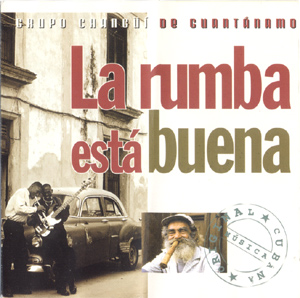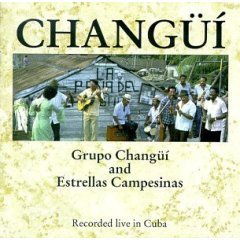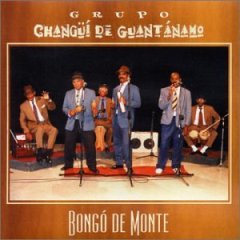Indice - Table of contents
New Stuff[hide]
Reportes: From The St... : Cubadisco 2...
Tienda: Cuban Music Store
Reportes: From The St... : Cubadisco 2...
Fotos: Tom Ehrlich
Staff: Kristina Lim
Musicos: Juan Formell
Musicos: Yordamis Megret Planes
Musicos: Yasser Morejón Pino
Musicos: José Luis "Changuito" Quintana...
Musicos: Dennis Nicles Cobas
Fotos: Eli Silva
Grupos: Ritmo Oriental : 1988 - Vol. IX - 30 a...
Musicos: Rafael Paseiro Monzón
Musicos: Jiovanni Cofiño Sánchez
Photos of the Day [hide]
LVV III - Un poco más lento - ¡Changüí!
Originating in Guantánamo over a century ago, changüí's influence on other Cuban genres has never waned. The son genre was created by mixing música trova (which used guitar, vocals, maracas, and later clave) with four elements borrowed from changüí:
1) The marímbula – a large kalimba-like bass instrument that emphasizes the ponche (it plays a doubled ponche on each side of the clave and various percussive sounds).
2) The tres – a small guitar-like instrument with three pairs of tightly tuned strings used to play the arpeggiated guajeos which were the progenitors of the accompaniment parts later played by piano, strings, and (eventually) bass.
3) The bongó – changüí used a larger bongó del monte, that played improvisationally behind the vocals.
4) The estribillo – the idea of a call and response repeating coro with interjections by the lead singer was already present in changüí in the Oriente when son groups began to adopt it.
By the time Elio Revé arrived in Havana from Guantánamo in the 1950s these elements had been propagated to every popular genre: son montuno, mambo, guaracha, chachachá, etc. The concepts were all there, but the music itself had changed so much that it no longer sounded anything like changüí so Revé created a new style of charanga with a fresh infusion of changüí elements. In the 80s and in the current group of Elio Revé, Jr., the changüí influence became even more pronounced.
In a more abstract way, changüí influenced the conga marchas of timba. Our approach to writing the middle volume of The Tomás Cruz Conga Method was to ask Tomasito which earlier rhythms were influential in timba conga drumming. Among the examples he gave was a special marcha that he said timba congueros call changüí because it resembles a variation figure sometimes played by the bongó del monte. Here are three examples: an excerpt from Grupo Changüí highlighting the original bongó del monte variation, a MIDI transcription of Tomasito's "changüí" marcha, and finally Manolito's conguero Evelio Ramos using the same marcha in context on Dame tu programa from Directo al corazón.
| Grupo Changüí | characteristic bongó del monte figure |
| MIDI | xxSx bxSx bxS0 ox0o |
| Manolito | "changüí" conga marcha in timba |
We've already discussed changüí 68, the direct predecessor to songo in Formell's work, but the final section of LVV III's opening suite is probably the most direct homage to changüí to be found in modern Cuban dance music. Let's compare a version by one of today's leading traditional changüí groups, Grupo Changüí de Guantánamo, to the Los Van Van version:
example 1: Grupo Changüí - LVV - As always, the traditional version begins with the tres playing the melody. Traditional changüí has no clave. The phrases are comprised mostly of offbeats and can have odd lengths and the tres often plays pasos de calle -- "breathing spaces" of indeterminate length. In the Van Van version, the phrasing is consistent, and Pupy fills the space between the phrases with catchy original keyboard counterpoint. Van Van's songo percussion isn't directly related to the original changüí, which consists only of guayo (güiro, sometimes metal), maracas, and the low pitched bongó del monte.
example 2: Grupo Changüí - LVV - In the traditional version the tres doubles the vocal; in the LVV version, Pupy's part is not only contrapuntal, but has a distinct "hook" factor that looks forward to the timba piano tumbaos of the 90s. With Pupy now playing tumbao, the flutes and violins take over the role of filling the breathing spaces with countermelodies. The role of the bass in traditional changüí is played by the marímbula, a giant kalimba of sorts. It has very limited range and its pitches, while vaguely related to the chord progression, are more like pitched percussion than bass notes. Its part is the doubled ponche (xxxx xx00). Formell plays bombo-ponche (xxx0 xx0x) and chooses notes that create a beautiful countermelody while fleshing out the chord progression implied by the sophisticated melody of the original.
example 3: Grupo Changüí - LVV
xx0x 0xxx 0xx0 xxx0 2-3 rumba clave
xxxx xxxx xxxx x0x0 (bass pickup)
xxx0 0xx0 0xx0 x0x0 tumbao 4 - MIDI example
notes: Formell, Pupy and Changuito all add interesting new songo material in their accompaniments while staying faithful to the feel and structure of the original.
example 4: Grupo Changüí - LVV - The music is obviously very different, but note Formell's use of the characteristic changüí vocal interjection to usher in a new rhythm. Leading changüí scholar Ben Lapidus points out that this "shout" is a standard part of almost all changüí arrangements, serving the purpose of cuing in a group instrumental entrance called the ejecución colectiva.
Changüí is a fascinating genre to which we'll return over and over in the course of this book. In the meantime, I'd highly recommend picking up at least one of the above CDs (the one on the left is my favorite so far), and listening carefully, making sure to focus on the maracas and scraper in order to hear the tres and vocals correctly. Also well worth reading is Ben Lapidus' book Changüí: Origins of Cuban Music and Dance.
1974 - Los Van Van - Mi ritmo caliente (Formell - Miró)
xx0x 0xxx 0xx0 xxx0 2-3 clave
0xx0 x0xx xxx0 xxxx kick
0xx0 0x00 x0x0 0x00 audio - MIDI
bass: Juan Formell drums: Changuito
source: La colección, Vol. III
notes: After the massive opening suite and the second track, which is itself a mini-suite of two ballads, track 3 is a basic one-groove dance track, co-authored by violinist Gerardo Miró, who stayed with Van Van until 2001 when he left, along with Pupy, for Los Que Son Son. At 94 bpm, this is quite a bit slower than a typical songo track, resulting in a slightly busier bass tumbao. Also, note the interplay between the kick, the bass and the keyboard parts.




















